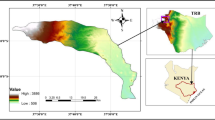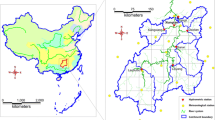Abstract
Vegetation information is seldom considered in lumped conceptual rainfall-runoff models. This paper uses two modified rainfall-runoff models, the Xinanjiang-ET and SIMHYD-ET models in which vegetation leaf area index is incorporated, to investigate impacts of vegetation change and climate variability on streamflow in a Southern Australian catchment, the Crawford River experimental catchment, where Tasmanian blue gum plantations were introduced gradually from 1998 till 2005. The Xinanjiang-ET and SIMHYD-ET models incorporate remotely-sensed leaf area index (LAI) data obtained from the Advanced Very High Resolution Radiometer (AVHRR) on board NOAA polar orbiting satellites. Compared to the original versions, the Xinanjiang-ET and SIMHYD-ET models show marginal improvements in runoff simulations in the pre-plantation period (1882–1997). The calibrated Xinanjaing-ET and SIMHYD-ET models are then used to simulate plantation impact on streamflow in the post-plantation period. The total change in streamflow between the pre-plantation and post-plantation periods is −32.4 mm/a. The modelling results from the two models show that plantation reduces streamflow by 20.5 mm/a, and climate variability reduces streamflow by 11.9 mm/a. These results suggest that increase in plantations can reduce streamflow substantially, even more than climate variability.
Similar content being viewed by others
References
Kittredge J. Forest Influences: The Effects of Woody Vegetation on Climate, Water, and Soil, with Appliactions to the Conservation of Water and the Control of Floods and Erosion. New York: Dover Publications, 1948
Bronstert A, Niehoff D, Burger G. Effects of climate and land-use change on storm runoff generation: present knowledge and modelling capabilities. Hydrol Process, 2002, 16(2): 509–529
Cheng G W, Yu X X, Zhao Y T. Hydrological Cycle in Mountain Forest Ecosystem and its Mathematical Modeling (in Chinese). Beijing: Science Press, 2004
Eagleson P S. Ecohydrology: Darwinian Expression of Vegetation Form and Function. Cambridge: Cambridge University Press, 2002
Zhao F F, Xu Z X, Zhang L, et al. Streamflow response to climate variability and human activities in the upper catchment of the Yellow River Basin. Sci China Ser E-Tech Sci, 2009, 52(11): 3249–3256
Bosch J M, Hewlett J D. A review of catchment experiments to determine the effect of vegetation changes on water yield and evapo-transpiration. J Hydrol, 1982, 55(1–4): 3–23
Ruprecht J K, Schofield N J. Effects of partial deforestation on hydrology and salinity in high salt storage landscapes. II. Strip, soils and parkland clearing. J Hydrol, 1991, 129(1–4): 39–55
Whitehead P G, Robinson M. Experimental basin studies-an international and historical-perspective of forest impacts. J Hydrol, 1993, 145(3–4): 217–230
Li C R, Tu L B. The influence of forests on the annual flow in rivers and its significance (in Chinese). J Nanjing Forest Uni, 1983, 3: 31–43
Zhou X F, Zhao H X, Sun H Z. Proper assessment for forest hydrological effect (in Chinese). J Nat Resour, 2001, 16: 420–426
Liu C M, Zhong J X. The influence of forest cover upon annual runoff in the loess plateau of China (in Chinese). Acta Geographica Sinica, 1978, 33(2): 112–127
Chen J F, Li X B. The impact of forest change on watershed hydrology — Discussing some controversies on forest hydrology (in Chinese). J Nat Resour, 2001, 16(5): 474–480
Fu C S, Chen J Y, Zeng S Q, et al. An overview on the water science researches at the experimental catchments in China and Abroad (in Chinese). Prog Geograp, 2011, 30(3): 259–267
Zhao F F, Zhang L, Xu Z X, et al. Evaluation of methods for estimating the effects of vegetation change and climate variability on streamflow. Water Resour Res, 2010, 46, doi: 10.1029/2009wr007702
Morton F I. Operational Estimates of Areal Evapo-Transpiration and Their Significance to the Science and Practice of Hydrology. J Hydrol, 1983, 66(1–4): 1–76
Monteith J L. Evaporation and environment. Symp Soc Exp Biol, 1965, 19: 205–234
Leuning R, Zhang Y Q, Rajaud A, et al. A simple surface conductance model to estimate regional evaporation using MODIS leaf area index and the Penman-Monteith equation. Water Resour Res, 2008, 44, doi: 10.1029/2007WR006562
Li H X, Zhang Y Q, Chiew F H S, et al. Predicting runoff in ungauged catchments by using Xinanjiang model with MODIS leaf area index. J Hydrol, 2009, 370(1–4): 155–162
Zhao R J. The Xinanjiang Model Applied in China. J Hydrol, 1992, 135(1–4): 371–381
Zhao R J, Zhang Y L, Fang L R, et al. The Xinanjiang Model. In: Hydrological Forecasting Proceedings Oxford Symposium. Oxford: IASH, 1980. 351–356
Wu X Y, Cheng C T, Zhao M Y. Parameter calibration of Xinanjiang rainfall-runoff model by using parallel genetic algorithm. J Hydraul Eng, 2004, 11: 85–90
Jayawardena A W, Zhou M C. A modified spatial soil moisture storage capacity distribution curve for the Xinanjiang model. J Hydrol, 2000, 227(1–4): 93–113
Cheng C T, Ou C P, Chau K W. Combining a fuzzy optimal model with a genetic algorithm to solve multi-objective rainfall-runoff model calibration. J Hydrol, 2002, 268(1–4): 72–86
Chiew F H S, Peel M C, Western A W. Application and testing of the simple rainfall-runoff model SIMHYD. In: Singh V P, Frevert D K, eds. Mathematical Models of Small Watershed Hydrology and Application. Littleton: Water resources Publication, 2002. 335–367
Chiew F H S. Estimation of rainfall elasticity of streamflow in Australia. Hydrolog Sci J, 2006, 51(4): 613–625
Zhang Y Q, Chiew F H S. Relative merits of different methods for runoff predictions in ungauged catchments. Water Resour Res, 2009, 45, doi: 10.1029/2008WR007504
Chiew F H S, Peel M C, Western A W. Application and testing of the simple rainfall-runoff model SIMHYD. In: Singh V P, Frevert D K, eds. Colorado: Water Resources Publication, 2002. 335–367
Yildiz O, Barros A P. Elucidating vegetation controls on the hydroclimatology of a mid-latitude basin. J Hydrol, 2007, 333(2–4): 431–448
Zhang Y Q, Chiew F H S, Zhang L. Use of remotely sensed actual evapotranspiration to improve rainfall-runoff modeling in Southeast Australia. American Meteor Society, 2009, 10(4): 969–980
Lewis R M. Torczon V. Pattern search algorithms for bound constrained minimization. Siam J Optimiz, 1999, 9(4): 1802–1099
Lewis R M. Torczon V. Pattern search methods for linearly constrained minimization. Siam J Optimiz, 2000, 10(3): 917–941
Nash J E, Sutcliffe J V. River flow forecasting through conceptual models part I-A discussion of principles. J Hydrol, 1970, 10(3): 282–290
Zhang X P, Zhang L, Zhao J, et al. Responses of streamflow to changes in climate and land use/cover in the Loess Plateau, China. Water Resour Res, 2008, 44, doi: 10.1029/2007WR006711
Wang G Q. Impacts of climate change on hydrology and water resources in the middle reaches of the Yellow River Basin (in Chinese). Dissertation of Doctoral Degree. Nanjing: Hohai University, 2006
Li D F. Impact of climate and land-cover change on runoff of the source regions of the Yellow River (in Chinese). Dissertation of Doctoral Degree. Beijing: Beijing Normal University, 2003
Author information
Authors and Affiliations
Corresponding author
Rights and permissions
About this article
Cite this article
Li, H., Zhang, Y. & Wang, B. Separating impacts of vegetation change and climate variability on streamflow using hydrological models together with vegetation data. Sci. China Technol. Sci. 55, 1964–1972 (2012). https://doi.org/10.1007/s11431-012-4859-9
Received:
Accepted:
Published:
Issue Date:
DOI: https://doi.org/10.1007/s11431-012-4859-9




